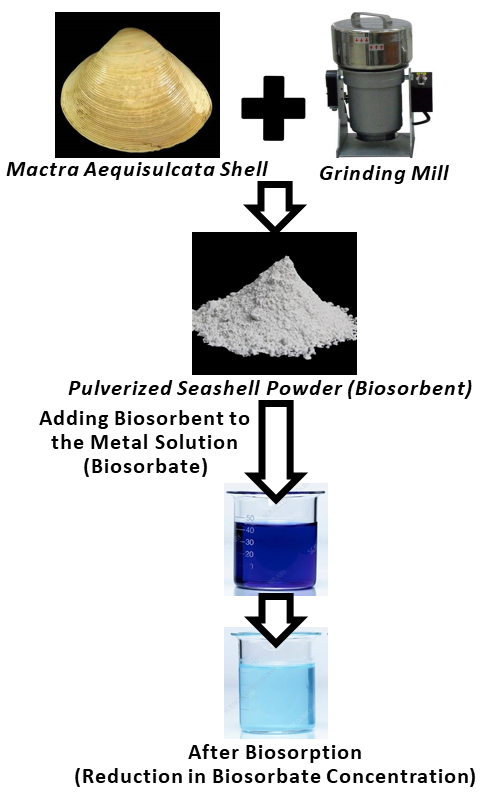A prudent approach for the removal of copper (II) and cadmium (II) ions from aqueous solutions using indigenous Mactra aequisulcata shells Scientific paper
Main Article Content
Abstract
In this study, the raw seashells of Mactra aequisulcata, of class Bivalvia and phylum Mollusca were employed as an adsorbent to remove copper (II) and cadmium (II) metal ions from aqueous solution. The characterization of shells was performed using FTIR, EDX and SEM, BET isotherm and point of zero charge (pHpzc). Batch experiments were performed to assess various factors on the biosorption efficiency. Maximum adsorption of both metals ions conveniently found at 0.4 g L-1 adsorbent dose, pH 5 and at 303 K. Maximum biosorption capacities for Cu2+ and Cd2+ were 59.57 and 38.12 mg g-1, respectively. The Langmuir isotherm model was found to be the best fit for the acquired equilibrium data. Thermodynamic and kinetic parameters presented that the process was feasible, exothermic and followed pseudo-first order.
Downloads
Metrics
Article Details

This work is licensed under a Creative Commons Attribution-NonCommercial-NoDerivatives 4.0 International License.

Authors retain copyright and grant the journal right of first publication with the work simultaneously licensed under a Creative Commons Attribution license 4.0 that allows others to share the work with an acknowledgement of the work's authorship and initial publication in this journal.
References
K. Nahar, M. A. K. Chowdhury, M. A. H. Chowdhury, A. Rahman, K. M. Mohiuddin, Environ. Sci. Pollut. Res. 25 (2018) 7954 (https://doi.org/10.1007/s11356-017-1166-9)
S. K. Bozbaş, Y. Boz, Process Saf. Environ. Prot. 103 (2016) 144 (https://doi.org/10.1016/j.psep.2016.07.007)
D. Gola, A. Malik, Z. A. Shaikh, T. R. Sreekrishnan, Environ. Process. 3 (2016) 1063 (https://doi.org/10.1007/s40710-016-0176-9)
O. Abdi, M. Kazemi, J. Mater. Environ. Sci. 6 (2015) 1386 (https://www.jmaterenvironsci.com/Document/vol6/vol6_N5/164-JMES-1454-2015-Abdi.pdf)
B. Bano, E. Zahir, Water Sci. Technol. 73 (2015) 1301 (https://doi.org/10.2166/wst.2015.590)
R. R. Crichton, Biological Inorganic Chemistry, Elsevier, Milan, 2007, p. 330 (https://doi.org/10.1016/B978-0-444-52740-0.X5024-8)
Y. Du, F. Lian, L. Zhu, Environ. Pollut. 159 (2011) 1763 (https://doi.org/10.1016/j.envpol.2011.04.017)
E. Jeon, S. Ryu, S. Park, L. Wang, D. C. W. Tsang, J. Clean. Prod. 176 (2017) 54 (https://doi.org/10.1016/j.jclepro.2017.12.153)
H. T. Van, L. H. Nguyen, V. D. Nguyen, X. H. Nguyen, T. H. Nguyen, T. V. Nguyen, S. Vigneswaran, J. Rinklebe, H. N. Tran, J. Environ. Manage. 241 (2019) 535 (http://hdl.handle.net/10453/128739)
Mactra aequisulcata Sowerby Iii 1894 - Encyclopedia of Life https://eol.org/pages/46471883, (28th January, 2021)
I. Langmuir, J. Am. Chem. Soc. 40 (1918) 136 (https://doi.org/10.1021/ja02242a004)
N. Ayawei, S. S. Angaye, D. Wankasi, E. D. Dikio, Open J. Phys. Chem. 5 (2015) 56
(https://doi.org/10.4236/ojpc.2015.53007)
H. Freundlich, Z. Phys. Chem. 57 (1907) 385 (https://doi.org/10.1515/zpch-1907-5723)
N. Ayawei, A. N. Ebelegi, D. Wankasi, J. Chem. 2017 (2017) (https://doi.org/10.1155/2017/3039817)
Z. Berizi, S. Y. Hashemi, M. Hadi, A. Azari, A. H. Mahvi1, Water Sci. Technol. 74 (2016) 1235 (https://doi.org/10.2166/wst.2016.320)
A. Shafiu Kamba, M. Ismail, T. A. Tengku Ibrahim, Z. A. B. Zakaria, J. Nanomater. 2013 (2013) (https://doi.org/10.1155/2013/398357)
D. Alidoust, M. Kawahigashi, S. Yoshizawa, H. Sumida, M. Watanabe, J. Environ. Manage. 150 (2015) 103 (https://doi.org/10.1016/j.jenvman.2014.10.032)
B. Zhao, J. E. Zhang, W. Yan, X. Kang, C. Cheng, Y. Ouyang, Desalin. Water Treat. 57 (2016) 23987 (https://doi.org/10.1080/19443994.2016.1140078)
A. Sdiri, T. Higashi, Appl. Water Sci. 3 (2013) 29 (https://doi.org/10.1007/s13201-012-0054-1)
H. N. Tran, S. You, H. Chao, Waste. Manage. Res. 34 (2016) 129 (https://doi.org/10.1177/0734242x15615698)
D. M. Veneu, C. L. Schneider, M. B. De Mello, O. Galvão, C. Cunha, L. Yokoyama, Environ. Technol. 39 (2018) 1670 (https://doi.org/10.1080/09593330.2017.1336574)
W. Wei, Q. Wang, A. Li, J. Yang, F. Ma, S. Pi, D. Wu, Sci. Rep. 6 (2016) 1 (https://doi.org/10.1038/srep31575)
A. Hossain, S. R. Bhattacharyya, G. Aditya, Wat. Res. 35 (2014) 3551 (https://doi.org/10.1016/S0043-1354(01)00099-9)
Y. Liu, C. Sun, J. Xu, Y. Li, J. Hazard. Mater. 168 (2009) 156 (https://doi.org/10.1016/j.jhazmat.2009.02.009)
S. Dahiya, R. M. Tripathi, A. G. Hegde, Bioresour. Technol. 99 (2008) 179 (https://doi.org/10.1016/j.biortech.2006.11.011)
F. A. Ismail, A. Z. Aris, Environ. Sci. Pollut. Res. 21 (2014) 344 (https://doi.org/10.1007/s11356-013-1906-4)
C. Zhou, X. Gong, W. Zhang, J. Han, R. Guo, Water Environ. Res. 89 (2017) 817 (https://doi.org/10.2175/106143017X14902968254854)
Y. Gao, Asian J. Chem. 25 (2013) 8537 (http://dx.doi.org/10.14233/ajchem.2013.14828A).





